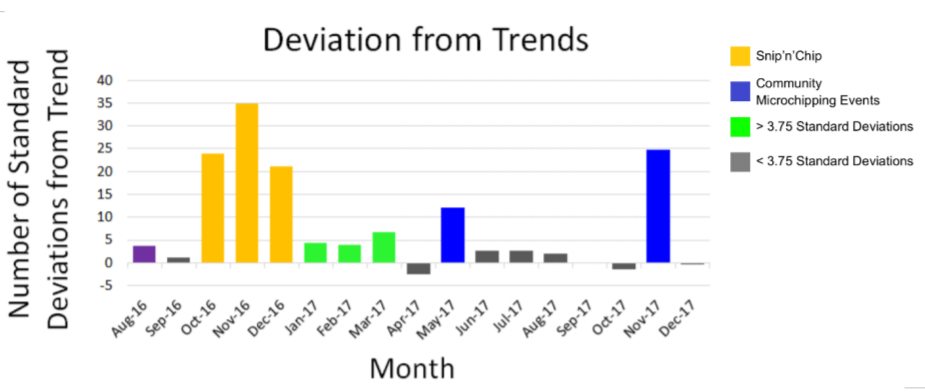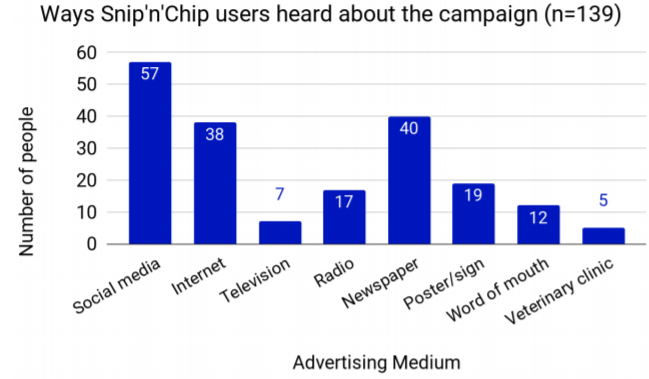Executive Summary
Introduction
The Wellington City Council (WCC) passed the Animal Bylaw in August 2016 and collaborated with the Society for the Prevention of Cruelty to Animals (SPCA) to run the Snip’n’Chip campaign from October to December of 2016. Effective February 2018, the bylaw requires cat owners to microchip their cats and register that microchip with the New Zealand Companion Animal Register (NZCAR). To help the public prepare for the bylaw, the Snip’n’Chip campaign provided significant discounts on microchipping and neutering procedures for pet cats in Wellington.
The goals of our project were to (1) evaluate the public’s awareness of, compliance with, and perceptions of the Animal Bylaw bylaw and to (2) evaluate the effectiveness of the Snip’n’Chip campaign, including most effective advertising strategies, perceptions of the campaign, and associated public behavior change from its users.
Methodology
Successful execution of this project required a diverse range of methods and data sources, including in-person surveys conducted at various locations around Wellington, surveys emailed to Snip’n’Chip users, a focus group, and NZCAR microchip registration data.
We conducted public convenience surveys to determine Wellington residents’ opinions on a variety of issues, including the Animal Bylaw, cat ownership, wildlife, and government involvement in cat management. To conduct the surveys, we deployed teams of two people to selected locations with high foot-traffic and no inherent bias.
Since the fraction of Wellington residents who used Snip’n’Chip was very small, we knew we would not be able to assess the program through these convenience surveys alone. Instead, we coordinated with the SPCA and WCC to send an online survey to Snip’n’Chip users via email. This survey had a variety of questions similar to those in our public survey, in addition to many that asked about the Snip’n’Chip campaign in particular.
Our surveys were effective for determining the public’s response to the bylaw and Snip’n’Chip campaign, but not their effects on microchipping. To account for this, we obtained the number of Wellington cat microchips registered each month from January 2010 to January 2018 from the NZCAR. We were able to analyze this data for trends and determine just how significantly the Animal Bylaw and Snip’n’Chip had affected the number of cats microchipped.
Our goals, objectives, and methods are outlined in Figure 1, below.
Figure 1: The goals of our project, the objectives we defined to reach those goals, and the methods used to complete each objective.
Results and Analysis
We collected 151 surveys from the Wellington population, including 48 cat owners and 103 non cat owners. From these surveys, we found that 86% of survey respondents (127 out of 148) had positive opinions on the bylaw. Reasons that respondents gave for agreeing with the bylaw are shown in Figure 2 below. Additionally, we found that 63% of cat owners (30 out of 48) were aware of the existence of the Animal Bylaw, but only 32% of non cat owners (33 out of 103) were aware of its existence. A majority of cat owners surveyed were also compliant with the bylaw at 81% (39 out of 48), but we found that awareness of the bylaw had little impact on compliance. Some of the reasons people had not microchipped their cats included having exclusively indoor cats, believing microchips are ineffective, having old cats, or thinking microchipping is too expensive.
Figure 2: Why people felt positively about the Animal Bylaw
We received 153 email survey responses from people who had used the Snip’n’Chip campaign. Based on this data, 33% (n=127) reported they would have been unable to microchip without Snip’n’Chip, and 39% (n=54) reported they would have been unable to neuter without Snip’n’Chip. Regardless of whether or not they could have afforded microchipping and/or neutering, participants noted that the discount was a huge incentive to use Snip’n’Chip. Figure 3 below summarizes reasons people would or would not have microchipped and/or neutered their cats without Snip’n’Chip.
Figure 3: Why people would/would not have microchipped or neutered their cats without Snip’n’Chip
Further, we found that people learned of the campaign most effectively through social media, the newspaper, and the internet (see Figure 4 below). The campaign did reach its targeted lower-income demographics, but perhaps not as effectively as it could have – according to the 2013 census, 61% of people earn less than $50,000 annually, but only 28% of Snip’n’Chip users who answered our survey reported this income.
Figure 4: The ways Snip’n’Chip users heard about the Snip’n’Chip campaign
From our analysis of the NZCAR microchip registration data from 2010 through 2017, we found that there has been a significant change in microchipping trends since the introduction of the bylaw and microchipping campaigns. Over the past several years, the number of cat microchips registered has increased roughly linearly (excluding subsidized microchipping events), but in the summer of 2017, the results deviate significantly positively from the trend. These results indicate that community microchipping events and Snip’n’Chip caused significantly more microchip implants that usually occur. A graphical representation of changes in microchipping trends is shown in Figure 5.
Figure 5: The deviation from the previous microchipping trendline for each month
Recommendations
From the combined results of our surveys, focus group, and research, we have produced recommendations for encouraging more responsible pet ownership and compliance with the bylaw, as well as for the Snip’n’Chip campaign (if another campaign is to happen). We recommend:
1. The WCC and SPCA use social media and work with local veterinary clinics to promote responsible pet ownership
2. Data-oriented outreach that uses credible New Zealand based studies to inform people how they can better protect native wildlife from cat predation (example is shown in Figure 6 below)
3. Outreach that uses testimonials to incite an emotional response and helps cat owners relate the benefits of being a responsible pet owner to their own cat
4. An eligibility verification process before Snip’n’Chip vouchers are purchased to better inform users of location requirements and medical requirements for use of the campaign
5. Extension of the Snip’n’Chip campaign to include after work hours
6. Organizations involved or invested in Snip’n’Chip predefine their expectations for each other so the campaign may be more easily evaluated in the future
Figure 6: Example of recommended data-oriented outreach using a social media post
We have also identified key areas that should be further researched to more thoroughly evaluate the effectiveness of the Animal Bylaw and Snip’n’Chip campaign. These areas include the effect of the bylaw and Snip’n’Chip on cat populations and the number of cats who are reunited with their owners, the relationship between income and compliance, the extent to which domestic cats are neutered in Wellington, and the reason for the disparity between cat owners’ beliefs and their actions.
Conclusion
This project aimed to (1) determines public awareness of, compliance with an opinion on the Animal Bylaw, (2) determine the effectiveness of the Snip’n’Chip campaign, and (3) produce recommendations for future outreach methods and Snip’n’Chip campaigns. We have found that most Wellington cat owners are in compliance with the bylaw, that most residents feel positively about the bylaw, that people who used Snip’n’Chip felt overwhelmingly positively about the program, and that there has been a significant increase in cat microchipping trends over the past few years. We recommend that the WCC and SPCA use data driven and emotional outreach on social media and in vet clinics, that Snip’n’Chip’s eligibility requirements are more clear, and that the WCC and SPCA communicate their goals and objectives more effectively.







